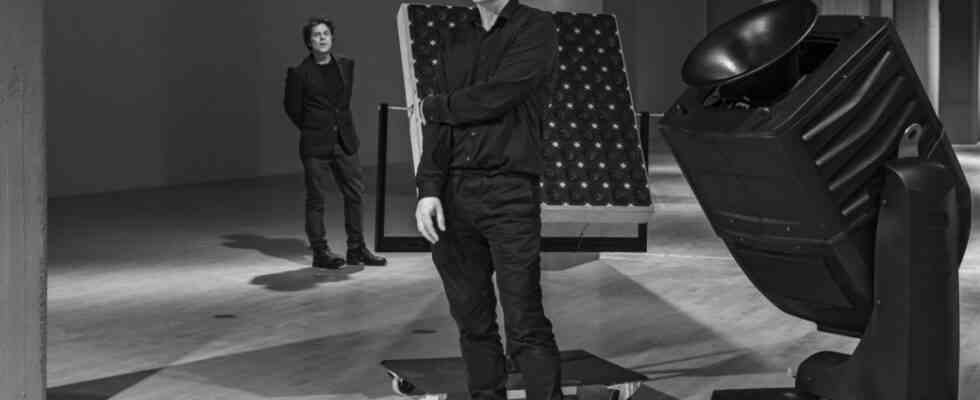Two ears meet two speakers. If the ears are also in the middle and in front of the speakers, then this results in the ideal-typical listening situation. The brain is also happy because it is used to the artificial stereo situation it has created itself.
In addition, human perception is quite lazy, usually falls back on the familiar and prefers to ignore the unknown. Nevertheless, one can now ask oneself: Does it have to be the case that we sit frontally and preferably quietly in front of the loudspeakers or musicians? Couldn’t we be somewhere else or even move between the speakers or musicians? And why don’t we take three, four or more loudspeakers and immerse ourselves in a completely new acoustic space?
This is exactly what you can currently do, from April 9th to September 18th, in the Kunstbau des Munich Lenbachhaus do and experience. There is the sound installation “Spatial Jitter” by the well-known Berlin-based electronic duo Mouse on Mars to see and above all to hear. The nice thing is that you can immerse yourself in this world of sound free of charge and during opening hours at any time of the day. And of course you can come back and expose yourself to the sounds there again. That is exactly what is recommended. Because even if the music program repeats itself after two hours, the experience will never be the same.
How so? Andi Toma and Jan St. Werner, who have been exploring the world of sounds since their debut album “Vulvaland” in 1994 and are particularly interested in artificial and mechanical sounds, have taken care of that. Their music was initially described as “Kraut Dub” or “Post Techno”, with which they actually docked onto genres such as Krautrock and Techno or even Ambient. But with an original, you could also say: crazy twist. From the studio to the stage or the DJ desk, they found their way into the museum as early as 2004 and organized the exhibition “Documentary/Fiction. Mouse On Mars Reviewed & Remixed” in the Düsseldorf Kunsthalle.
Role models are Iannis Xenakis, Karlheinz Stockhausen or La Monte Young
So now the art. There, Toma and St. Werner installed a spinning spotlight-based horn speaker, several speaker objects created by Michael Akstaller, percussion robots suspended from the ceiling created by Moritz Simon Geist, and all with a Matthias Singer-produced, light installation concentrated largely on the floor. First of all, that means it’s relatively dark when you go into the 15-meter-wide, five-meter-high and 110-meter-long room that is located above the “Königsplatz” underground station.
The first notes? It can be a click or a jingle, something that sounds like sawing or distorted strings, or like the dull hum or boom from an adjacent disco. Some things appear harmonious, many things disharmonious. And above all: the place of origin of all these noises is often difficult to identify. In fact, it is usually the horn speaker that spits out sounds into the frenzy, which at some point almost runs amok, rears up and spins wildly. Only: The sounds cross and break on the walls, are directed or reflected by the other speakers. And the percussion robots on the ceiling join in too.
Stylistically, the whole thing docks with New Music. Mouse on Mars themselves name figures like Iannis Xenakis, Karlheinz Stockhausen or La Monte Young as role models. At the press conference, the curator Eva Huttenbach and the director of the Lenbachhaus Matthias Mühling also mentioned Arnold Schönberg or the Futurist artist Luigi Russolo as possible references. In any case, it is not far to the artist group Blauer Reiter, which is important for the Lenbachhaus. Also because, according to Matthias Mühling, “Spatial Jitter” with sound, light, color, light and movement is about the elementary things of art, as analyzed by Wassily Kandinsky.
Synaesthesia was also important for Kandinsky, i.e. the phenomenon that someone can perceive sounds as colors. A phenomenon that breaks through genre boundaries, but which artists are usually not interested in anyway. According to Mühling, dividing the arts into disciplines and houses originates from the bourgeois pigeonhole world. In the Lenbachhaus, however, one tries to avoid this separation. Examples of this? The 2011 Kraftwerk installation in the Kunstbau, or the concerts by Julius Eastman that took place there last February and March. And if you look at series of events like “Tune” in the Haus der Kunst, you can currently see similar developments there.
It also fits that art students will play the music at the opening of “Spatial Jitters” on April 8th. That means members of the collective DAF (Dynamic Acoustic Research) who belong to the sound art classes that Jan St. Werner teaches in Nuremberg and Munich. Mouse on Mars will perform on June 24th and July 29th and play a concert at Muffathalle on September 9th.
The “catalogue” for the exhibition? Of course it’s a record. Nevertheless, there are several texts in its booklet, and you can listen to the music from the installation. It sounds a little different on record. But if you have a DTS multi-channel system from the nineties at home, according to Andi Toma, you would come pretty close to the original.
Mouse on Mars. Spatial Jitter, Fri., April 8, 7 p.m. (opening), to Sep. 18, Art building/Lenbachhaussubway mezzanine Königsplatz

